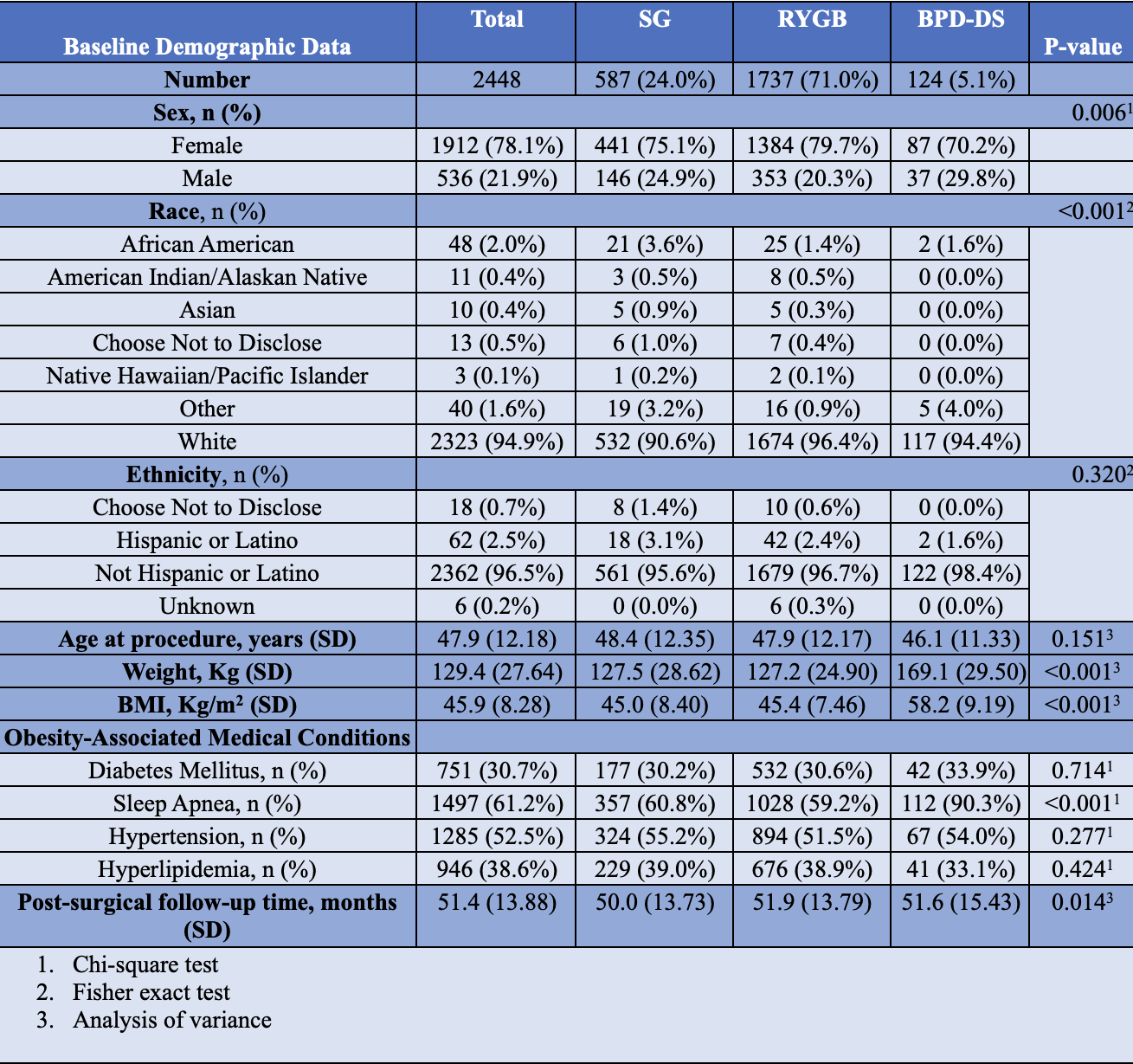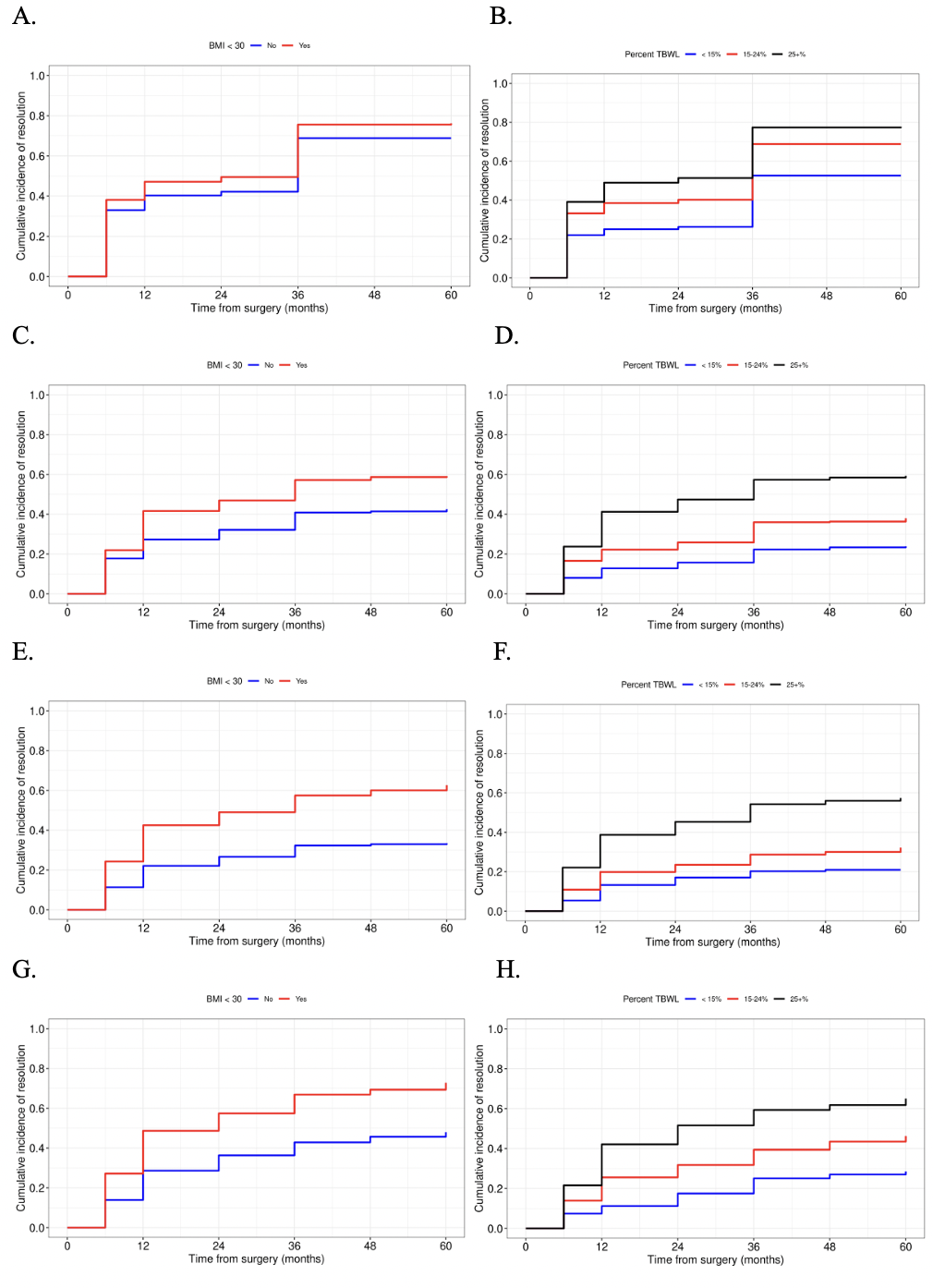Tuesday Poster Session
Category: Diet, Nutrition, and Obesity
P4843 - Redefining Success in Bariatric Surgery: Total Body Weight Loss Thresholds Predict Remission of Obesity-Related Medical Conditions
Tuesday, October 28, 2025
10:30 AM - 4:00 PM PDT
Location: Exhibit Hall
- WG
Wissam Ghusn, MD
Boston Medical Center
Boston, MA
Presenting Author(s)
Wissam Ghusn, MD1, Robert A. Vierkant, MS2, Noura Jawhar, MBBS2, Nour El Ghazal, MBBS2, Andres Acosta, MD2, Omar M. Ghanem, MD2
1Boston Medical Center, Boston, MA; 2Mayo Clinic, Rochester, MN
Introduction: Metabolic and bariatric surgery (MBS) is the most effective long-term treatment for severe obesity and leads to resolution of obesity-related medical conditions (ORMC) including type 2 diabetes (T2D), hypertension (HTN), hyperlipidemia (HLP), and obstructive sleep apnea (OSA). However, surgical success remains defined by arbitrary weight-based endpoints, such as total body weight loss (TBWL) >20% or BMI < 30 kg/m², rather than remission of disease. The optimal degree of weight loss required to achieve ORMC resolution is not well established.
Methods: We conducted a retrospective cohort study of adults who underwent primary sleeve gastrectomy (SG), Roux-en-Y gastric bypass (RYGB), or biliopancreatic diversion with duodenal switch (BPD-DS) at a single academic center between 2008–2023. Patients were stratified by time-updated TBWL (< 15%, 15–24%, ≥25%) and residual BMI (< 30 vs ≥30 kg/m²). The primary outcome was ORMC remission, defined as off-treatment normalization of clinical parameters sustained at two visits ≥3 months apart. Multivariable Cox models estimated adjusted hazard ratios (aHRs) for remission by TBWL and BMI category, stratified by procedure.
Results: Among 2,448 patients (mean age 48 ± 12 years; 78% female), median follow-up was 51 months (Table 1). Achieving ≥25% TBWL was significantly associated with higher remission rates for T2D (aHR 1.43; 95% CI 1.04–1.96; Figure 1A-B), HTN (aHR 2.43; 1.70–3.47; Figure 1C-D), HLP (aHR 2.42; 1.53–3.82; Figure 1E-F), and OSA (aHR 2.40; 1.75–3.28; Figure 1G-H) compared to < 15% TBWL. Intermediate TBWL (15–24%) was also associated with improved remission for HTN and OSA but not for T2D or HLP. In contrast, a BMI < 30 kg/m² was not significantly associated with T2D remission and performed inconsistently across other endpoints. Procedure-specific models showed the strongest TBWL-remission gradients after SG, though TBWL remained predictive across all procedures.
Discussion: In this large cohort, total body weight loss (TBWL) emerged as the most clinically meaningful predictor of ORMC remission following bariatric surgery. Achieving ≥25% TBWL was associated with significantly greater resolution of T2D, HTN, HLP, and OSA, while even 15–24% TBWL conferred benefits for select conditions. These findings support using TBWL-based thresholds, rather than universal BMI targets, to guide postoperative goals, better align surgical success with metabolic outcomes, and inform individualized care.

Figure: Table 1: Demographic and clinical distribution of the MBS cohort.

Figure: Figure 1: ORMC resolution by BMI <30, and by TBWL <15%, 15-24%, >25% for T2D (A, B), HTN (C, D), HLP (E, F), and OSA (G, H), respectively.
Disclosures:
Wissam Ghusn indicated no relevant financial relationships.
Robert A. Vierkant indicated no relevant financial relationships.
Noura Jawhar indicated no relevant financial relationships.
Nour El Ghazal indicated no relevant financial relationships.
Andres Acosta: Phenomix sciences – Royalties. Rhythm Pharmaceuticals, Gila Therapeutics, Amgen, General Mills, Regeneron, Boehringer Ingelheim, Novo Nordisk, Currax, Nestlé, Phenomix Sciences – Consultant, Grant/Research Support.
Omar Ghanem indicated no relevant financial relationships.
Wissam Ghusn, MD1, Robert A. Vierkant, MS2, Noura Jawhar, MBBS2, Nour El Ghazal, MBBS2, Andres Acosta, MD2, Omar M. Ghanem, MD2. P4843 - Redefining Success in Bariatric Surgery: Total Body Weight Loss Thresholds Predict Remission of Obesity-Related Medical Conditions, ACG 2025 Annual Scientific Meeting Abstracts. Phoenix, AZ: American College of Gastroenterology.
1Boston Medical Center, Boston, MA; 2Mayo Clinic, Rochester, MN
Introduction: Metabolic and bariatric surgery (MBS) is the most effective long-term treatment for severe obesity and leads to resolution of obesity-related medical conditions (ORMC) including type 2 diabetes (T2D), hypertension (HTN), hyperlipidemia (HLP), and obstructive sleep apnea (OSA). However, surgical success remains defined by arbitrary weight-based endpoints, such as total body weight loss (TBWL) >20% or BMI < 30 kg/m², rather than remission of disease. The optimal degree of weight loss required to achieve ORMC resolution is not well established.
Methods: We conducted a retrospective cohort study of adults who underwent primary sleeve gastrectomy (SG), Roux-en-Y gastric bypass (RYGB), or biliopancreatic diversion with duodenal switch (BPD-DS) at a single academic center between 2008–2023. Patients were stratified by time-updated TBWL (< 15%, 15–24%, ≥25%) and residual BMI (< 30 vs ≥30 kg/m²). The primary outcome was ORMC remission, defined as off-treatment normalization of clinical parameters sustained at two visits ≥3 months apart. Multivariable Cox models estimated adjusted hazard ratios (aHRs) for remission by TBWL and BMI category, stratified by procedure.
Results: Among 2,448 patients (mean age 48 ± 12 years; 78% female), median follow-up was 51 months (Table 1). Achieving ≥25% TBWL was significantly associated with higher remission rates for T2D (aHR 1.43; 95% CI 1.04–1.96; Figure 1A-B), HTN (aHR 2.43; 1.70–3.47; Figure 1C-D), HLP (aHR 2.42; 1.53–3.82; Figure 1E-F), and OSA (aHR 2.40; 1.75–3.28; Figure 1G-H) compared to < 15% TBWL. Intermediate TBWL (15–24%) was also associated with improved remission for HTN and OSA but not for T2D or HLP. In contrast, a BMI < 30 kg/m² was not significantly associated with T2D remission and performed inconsistently across other endpoints. Procedure-specific models showed the strongest TBWL-remission gradients after SG, though TBWL remained predictive across all procedures.
Discussion: In this large cohort, total body weight loss (TBWL) emerged as the most clinically meaningful predictor of ORMC remission following bariatric surgery. Achieving ≥25% TBWL was associated with significantly greater resolution of T2D, HTN, HLP, and OSA, while even 15–24% TBWL conferred benefits for select conditions. These findings support using TBWL-based thresholds, rather than universal BMI targets, to guide postoperative goals, better align surgical success with metabolic outcomes, and inform individualized care.

Figure: Table 1: Demographic and clinical distribution of the MBS cohort.

Figure: Figure 1: ORMC resolution by BMI <30, and by TBWL <15%, 15-24%, >25% for T2D (A, B), HTN (C, D), HLP (E, F), and OSA (G, H), respectively.
Disclosures:
Wissam Ghusn indicated no relevant financial relationships.
Robert A. Vierkant indicated no relevant financial relationships.
Noura Jawhar indicated no relevant financial relationships.
Nour El Ghazal indicated no relevant financial relationships.
Andres Acosta: Phenomix sciences – Royalties. Rhythm Pharmaceuticals, Gila Therapeutics, Amgen, General Mills, Regeneron, Boehringer Ingelheim, Novo Nordisk, Currax, Nestlé, Phenomix Sciences – Consultant, Grant/Research Support.
Omar Ghanem indicated no relevant financial relationships.
Wissam Ghusn, MD1, Robert A. Vierkant, MS2, Noura Jawhar, MBBS2, Nour El Ghazal, MBBS2, Andres Acosta, MD2, Omar M. Ghanem, MD2. P4843 - Redefining Success in Bariatric Surgery: Total Body Weight Loss Thresholds Predict Remission of Obesity-Related Medical Conditions, ACG 2025 Annual Scientific Meeting Abstracts. Phoenix, AZ: American College of Gastroenterology.

